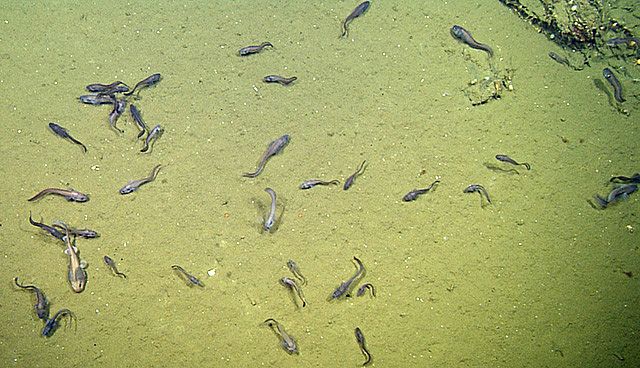
Researchers have observed hundreds of fish living in an inhospitable environment where there is virtually no oxygen—an element crucial to the survival of animal life as we know it.
The creatures were spotted deep in the Gulf of California—home to some of the most low-oxygen waters in the world—with the help of a submersible robot, according to a paper published in the journal Ecology.
Read more: Remember Mr. Blobby, the world's ugliest fish? Meet his cousin
Scientists from the Scripps Institution of Oceanography and the Monterey Bay Aquarium Research Institute (MBARI) say the low levels of oxygen in the habitat the animals were found in would prove fatal for most other fish.
They made their findings during a research expedition conducted in 2015, which was aimed at investigating various deep ocean basins in the Gulf using an underwater remote control vehicle known as Doc Ricketts.
The team also wanted to examine how animals respond to the kind of warmer and reduced oxygen conditions, which may become more common as a result of climate change. The Gulf is a perfect space to do this as its waters vary hugely in terms of oxygen levels and temperature.
Dives with the underwater robot in the central and southern Gulf revealed a fascinating array of creatures where there should have been very little life at all.
"I could hardly believe my eyes," Natalya Gallo, lead author of the paper from Scripps, wrote on MBARI's blog, referring to one region known as Cerralvo Trough. "We observed cusk eels, grenadiers and lollipop catsharks actively swimming around in areas where the oxygen concentration was less than one percent of typical surface oxygen concentrations."
Furthermore, data collected by Doc Ricketts showed that the oxygen levels were between one-tenth and one-fortieth of those tolerated by other fish known to live in low-oxygen environments.
"We were in a suboxic habitat, which should exclude fish, but instead there were hundreds of fish," Gallo said. "I immediately knew this was something special that challenged our existing understanding of the limits of hypoxia [low-oxygen] tolerance."
Surprisingly, the scientists even noticed that the cusk eels and lollipop sharks appeared to have a preference for the low-oxygen areas, despite the fact they had the option of moving to waters where levels of the element were higher.
"Many other types of fish are considered tolerant of low-oxygen conditions," Jim Barry, a scientist from MBARI who led the research expedition, said. "But the fish in these parts of the Gulf are like the winners among a group of elite Olympic athletes."
At present, it is unclear how the fish can thrive in this environment, although the researchers speculate that some of the species may have particularly efficient gills highly adapted to their low-oxygen habitat.
"To our knowledge, the catshark and cusk eel represent the most hypoxia [oxygen deficiency] tolerant fish species known," Gallo told Newsweek. "Interestingly, the catshark is a cartilaginous fish and the cusk eel is a bony fish, suggesting similar hypoxia tolerance potential in both distinct evolutionary lineages of fishes. However, since they are deep-sea species, very little is known about their physiologies and adaptations."
"We know that both species exhibit gill morphology adaptations that help them efficiently extract the limited oxygen from the water," she said. "For example, the small catshark is called the 'lollipop' shark because its extensive gill chambers make its head region look very large relative to its body size. We also observed that the cusk eel has bright red gills, suggesting high hemoglobin concentrations that help to bind more oxygen."
Furthermore, the animals have other features that could help them to conserve energy—and thus use less oxygen—such as being small and having soft, flabby bodies.
"Both species are also relatively small, usually less than a foot in length at full size, and this small body size may also be an adaptation to living under extreme hypoxic conditions," Gallo said. "Both species likely have an assortment of adaptations that allow them to thrive under conditions that would be immediately fatal to the vast majority of fish."
"In the paper, we propose the term 'ligooxyphile,' meaning an organism specialized to live under severely hypoxic conditions, to facilitate more comparisons of low oxygen specialists and their adaptations across different ecosystems —deep ocean, ice-covered ponds, some cave environments, et cetera," she said.
The scientists say that further research is needed to understand why so many fish gather in these harsh waters, but they propose two main hypotheses.
"First, the highest densities of fish were observed in an area called the Cerralvo Trough—bathymetric features like troughs or submarine canyons can channel and concentrate food sinking down from the surface, so can be areas of higher food accumulation," Gallo said.
"The second hypothesis is that these fish appear to prefer this extremely hypoxic habitat, which likely excludes all of their natural predators, and potentially other animals that they may be competing for food with. So, by adapting to live in these extreme conditions, they can live in areas that are refuges from predators."
According to Gallo, the latest discovery is significant because it challenges our assumptions about fish, suggesting that they have a much higher potential for hypoxia tolerance than previously appreciated. This could have implications in the field of marine biology and beyond.
"Understanding hypoxia tolerance and adaptation is quite a central topic in the medical field, connecting cancer biology, the study of stroke/heart attack damage and recovery, and the study of placental oxygen delivery during fetal development, et cetera. The requirement, delivery of, and use of oxygen is just so central to aerobic life," Gallo said.
"From a marine ecological point of view, climate change is causing the oceans to warm up and lose oxygen, and species that are highly adapted to living under metabolically challenging conditions may expand their ranges in the future, so that is of interest," she said. "Perhaps these fishes may be climate change 'winners.' Overall, the discovery is significant because it opens the door for more nuanced understanding of what conditions are necessary for life in a pretty complex group of animals—fishes."
This article was updated to include comments from Natalya Gallo.
Uncommon Knowledge
Newsweek is committed to challenging conventional wisdom and finding connections in the search for common ground.
Newsweek is committed to challenging conventional wisdom and finding connections in the search for common ground.
About the writer
Aristos is a Newsweek science reporter with the London, U.K., bureau. He reports on science and health topics, including; animal, ... Read more
To read how Newsweek uses AI as a newsroom tool, Click here.








